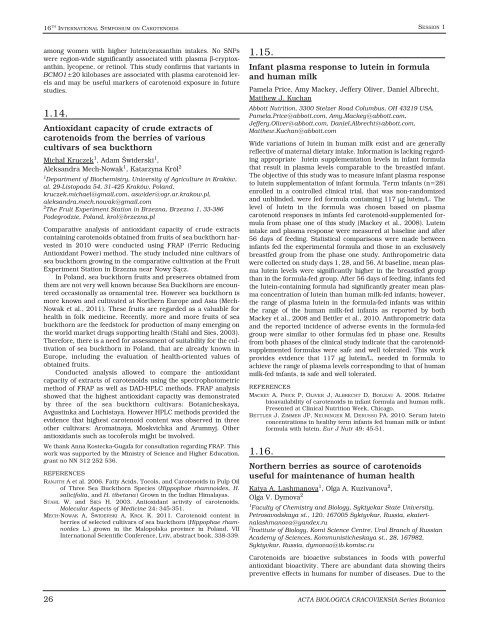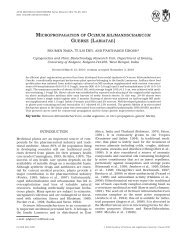ACTA BIOLOGICA CRACOVIENSIA
ACTA BIOLOGICA CRACOVIENSIA
ACTA BIOLOGICA CRACOVIENSIA
Create successful ePaper yourself
Turn your PDF publications into a flip-book with our unique Google optimized e-Paper software.
16 TH INTERNATIONAL SYMPOSIUM ON CAROTENOIDS<br />
among women with higher lutein/zeaxanthin intakes. No SNPs<br />
were region-wide significantly associated with plasma β-cryptoxanthin,<br />
lycopene, or retinol. This study confirms that variants in<br />
BCMO1±20 kilobases are associated with plasma carotenoid levels<br />
and may be useful markers of carotenoid exposure in future<br />
studies.<br />
1.14.<br />
Antioxidant capacity of crude extracts of<br />
carotenoids from the berries of various<br />
cultivars of sea buckthorn<br />
Michał Kruczek1 , Adam Świderski1 ,<br />
Aleksandra Mech-Nowak 1 , Katarzyna Król2 1Department of Biochemistry, University of Agriculture in Kraków,<br />
al. 29-Listopada 54, 31-425 Kraków, Poland,<br />
kruczek.michael@gmail.com, aswider@ogr.ar.krakow.pl,<br />
aleksandra.mech.nowak@gmail.com<br />
2The Fruit Experiment Station in Brzezna, Brzezna 1, 33-386<br />
Podegrodzie, Poland, krol@brzezna.pl<br />
Comparative analysis of antioxidant capacity of crude extracts<br />
containing carotenoids obtained from fruits of sea buckthorn harvested<br />
in 2010 were conducted using FRAP (Ferric Reducing<br />
Antioxidant Power) method. The study included nine cultivars of<br />
sea buckthorn growing in the comparative cultivation at the Fruit<br />
Experiment Station in Brzezna near Nowy Sącz.<br />
In Poland, sea buckthorn fruits and preserves obtained from<br />
them are not very well known because Sea Buckthorn are encountered<br />
occasionally as ornamental tree. However sea buckthorn is<br />
more known and cultivated at Northern Europe and Asia (Mech-<br />
Nowak et al., 2011). These fruits are regarded as a valuable for<br />
health in folk medicine. Recently, more and more fruits of sea<br />
buckthorn are the feedstock for production of many emerging on<br />
the world market drugs supporting health (Stahl and Sies, 2003).<br />
Therefore, there is a need for assessment of suitability for the cultivation<br />
of sea buckthorn in Poland, that are already known in<br />
Europe, including the evaluation of health-oriented values of<br />
obtained fruits.<br />
Conducted analysis allowed to compare the antioxidant<br />
capacity of extracts of carotenoids using the spectrophotometric<br />
method of FRAP as well as DAD-HPLC methods. FRAP analysis<br />
showed that the highest antioxidant capacity was demonstrated<br />
by three of the sea buckthorn cultivars: Botanicheskaya,<br />
Avgustinka and Luchistaya. However HPLC methods provided the<br />
evidence that highest carotenoid content was observed in three<br />
other cultivars: Aromatnaya, Moskvichka and Arumnyj. Other<br />
antioxidants such as tocoferols might be involved.<br />
We thank Anna Kostecka-Gugała for consultation regarding FRAP. This<br />
work was supported by the Ministry of Science and Higher Education,<br />
grant no NN 312 252 536.<br />
REFERENCES<br />
RANJITH A et al. 2006. Fatty Acids, Tocols, and Carotenoids in Pulp Oil<br />
of Three Sea Buckthorn Species (Hippophae rhamnoides, H.<br />
salicifolia, and H. tibetana) Grown in the Indian Himalayas.<br />
STAHL W. and SIES H. 2003. Antioxidant activity of carotenoids.<br />
Molecular Aspects of Medicine 24: 345-351.<br />
MECH-NOWAK A, ŚWIDERSKI A, KROL K. 2011. Carotenoid content in<br />
berries of selected cultivars of sea buckthorn (Hippophae rhamnoides<br />
L.) grown in the Malopolska province in Poland, VII<br />
International Scientific Conference, Lviv, abstract book, 338-339.<br />
1.15.<br />
Infant plasma response to lutein in formula<br />
and human milk<br />
Pamela Price, Amy Mackey, Jeffery Oliver, Daniel Albrecht,<br />
Matthew J. Kuchan<br />
Abbott Nutrition, 3300 Stelzer Road Columbus, OH 43219 USA,<br />
Pamela.Price@abbott.com, Amy.Mackey@abbott.com,<br />
Jeffery.Oliver@abbott.com, Daniel.Albrecht@abbott.com,<br />
Matthew.Kuchan@abbott.com<br />
Wide variations of lutein in human milk exist and are generally<br />
reflective of maternal dietary intake. Information is lacking regarding<br />
appropriate lutein supplementation levels in infant formula<br />
that result in plasma levels comparable to the breastfed infant.<br />
The objective of this study was to measure infant plasma response<br />
to lutein supplementation of infant formula. Term infants (n=28)<br />
enrolled in a controlled clinical trial, that was non-randomized<br />
and unblinded, were fed formula containing 117 μg lutein/L. The<br />
level of lutein in the formula was chosen based on plasma<br />
carotenoid responses in infants fed carotenoid-supplemented formula<br />
from phase one of this study (Mackey et al., 2008). Lutein<br />
intake and plasma response were measured at baseline and after<br />
56 days of feeding. Statistical comparisons were made between<br />
infants fed the experimental formula and those in an exclusively<br />
breastfed group from the phase one study. Anthropometric data<br />
were collected on study days 1, 28, and 56. At baseline, mean plasma<br />
lutein levels were significantly higher in the breastfed group<br />
than in the formula-fed group. After 56 days of feeding, infants fed<br />
the lutein-containing formula had significantly greater mean plasma<br />
concentration of lutein than human milk-fed infants; however,<br />
the range of plasma lutein in the formula-fed infants was within<br />
the range of the human milk-fed infants as reported by both<br />
Mackey et al., 2008 and Bettler et al., 2010. Anthropometric data<br />
and the reported incidence of adverse events in the formula-fed<br />
group were similar to other formulas fed in phase one. Results<br />
from both phases of the clinical study indicate that the carotenoidsupplemented<br />
formulas were safe and well tolerated. This work<br />
provides evidence that 117 μg lutein/L, needed in formula to<br />
achieve the range of plasma levels corresponding to that of human<br />
milk-fed infants, is safe and well tolerated.<br />
REFERENCES<br />
MACKEY A, PRICE P, OLIVER J, ALBRECHT D, BOILEAU A. 2008. Relative<br />
bioavailability of carotenoids in infant formula and human milk.<br />
Presented at Clinical Nutrition Week, Chicago.<br />
BETTLER J, ZIMMER JP, NEURINGER M, DERUSSO PA. 2010. Serum lutein<br />
concentrations in healthy term infants fed human milk or infant<br />
formula with lutein. Eur J Nutr 49: 45-51.<br />
1.16.<br />
Northern berries as source of carotenoids<br />
useful for maintenance of human health<br />
Katya A. Lashmanova1 , Olga A. Kuzivanova2 ,<br />
Olga V. Dymova2 SESSION 1<br />
1 Faculty of Chemistry and Biology, Syktyvkar State University,<br />
Petrosavodskaya st., 120, 167005 Syktyvkar, Russia, ekaterinalashmanova@yandex.ru<br />
2 Institute of Biology, Komi Science Centre, Ural Branch of Russian<br />
Academy of Sciences, Kommunisticheskaya st., 28, 167982,<br />
Syktyvkar, Russia, dymovao@ib.komisc.ru<br />
Carotenoids are bioactive substances in foods with powerful<br />
antioxidant bioactivity. There are abundant data showing theirs<br />
preventive effects in humans for number of diseases. Due to the<br />
26 <strong>ACTA</strong> <strong>BIOLOGICA</strong> <strong>CRACOVIENSIA</strong> Series Botanica












